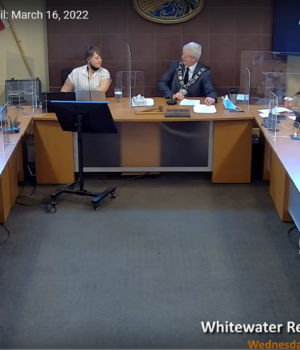The Council of the Township of Whitewater Region heard a motion to:
- Receive the Westmeath Provincial Park Flood Risk Assessment Final Report, prepared by Jp2G Consultants Inc., as a guiding document; and
- Direct staff to incorporate any action items into existing 2022 departmental workplan initiatives and report back as necessary.
Andrea Bishop and Stephen Arends of JP2G Consulting presented the report to Council.
“The study encompasses many grandfathered properties within the flood area and flood-fringe.” Bishop said. “These areas present a considerable flood risk in the spring flood period.”
“Seasonally the water rises, but there’s no damage.” She said, though she said that in 2017 sandbags were employed as a flood prevention measure, but that they were ‘unsuccessful.”
“No flood mitigation methods were successful during the 2019 flood” she said, saying that some residents had installed retaining walls or rock walls or raised their structures in response to the flooding.
She said that several residents had applied for funds for repairs only permanent residents could receive disaster flood assistance, and so very few qualified.
Arends said that the floodplain elevations had the potential to reach 112.5 based on a flood-plain mapping done in the 1980s.
“When we worked through the evaluation, and we did an on-site survey of what the evaluation and our surveyor down the road got an elevation of what it was like in 2019, and it was about 111.93.” he said.
“It didn’t get that high, but it certainly could get that high.”
He said tht climate change would lead to “An increase in frequency of flood events.”, and he said that there were difficulties in measuring that.
“It’s difficult to get an analysis one, or at least a small scale analysis.” he said.
“We don’t have control over the dam, we don’t really know how to play out what the dam is going to do in certain situations.” he said “A small-scale study of this just did not provide meaningful results. What we do know is that the flooding did get very significantly high, and while it didn’t reach that flood assessment, it did get close.”
He said that the lack of meaningful results made it was difficult to select solutions and practices, based on feasibility for individual owners and difficulty to implement.
“Sandbag barriers are only effective if everybody does it.” he said. “Flood-proofing homes seems to be the best solution for everybody, followed by raised homes and sandbags.”
He said that in their action plan, most immediate solution was to sandbag until a more permanent solution can be implemented.
“Short-term solution is to flood-proof houses, and the long-term is to raise the houses over the time.”
Bishop said that “due to the multi-jurisdictional nature of the Ottawa River, the , it’s very difficult to quantify the flow at the study area.”
She said they recommended a water gauge be installed in the Westmeath basin, and that they undertake a flood plain analysis to determine a 1:100 year flood line elevation.
“I don’t know what I was expected, but what’s come back every loud and clear but it’s a very complex and impossible to implement plan.” Councillor Nicholson said. “I think it was important to engage the community like this.”
Councillor Nicholson then asked if there was a study of wave-action for this area, rather than one from Pembroke.
“I think the only one is the one further away.” he said. “When they did it, they didn’t do it all the way. That was the study that we were provided for. I haven’t seen anything closer to our site that we can use.”
“To me it’s important to have the right height if we are encouraging this kind of investment.” Nicholson said, saying that the waves from the River would push the flooding beyond the initial mapped range.
“Because of that it doesn’t really clarify completely what we could expect with climate change.” he said. “because of what we do know, it will be a substantially larger effort to implement.”
“We have to accept that we have 105 buildings all in a floodplain between varying degrees of one foot other to seven or eight feet under.” Nicholson said. “We have to set some parameters for what we can do with those structures. If money is no object, and someone wants to come in and rebuild, is that something we can decide on? I want to give them some guidance on what they can do.”
“We got the funding for this work under the National Disaster Mitigation Program.” CAO Trembley said. “The funds are actually federal, but we applied for it through the province. For us to apply for floodplain mapping, we had to go through the flood risk assessment. To apply for the mapping or the gauge, we had to go through this step.”
He said that some of the rebuilding was zoning related, and that the Township did pass zoning bylaws regarding flood guidelines.
“I should point out that most of these properties are on private roads, so we don’t have infrastructure here. They can raise their homes, but there are also access issues.” Trembley said. “Very complex issues, most of these properties have wetlands behind them, they’re in the floodway. With this work, we can move forward to the next step. We’ve asked others to put the flood gauge in and they’ve told us politely no.”
Lane Cleroux said that the 1991 study of wave-action in Pembroke study were included in the flood plain study, as they also included the Westmeath area.
Councillor Jackson questioned if there should be a report on the costs of any implementations. “This gives them a blank slate with no dollar values attached, do you not want to include that in the motion? Would you not want to bring back a report to say ‘ok, from this report, we recommend these items be addressed and then. I think that sometimes we lose sight that we’re giving staff direction to do stuff and we’ve not giving consideration to what the cost is.”
CAO Trembley said it was merely to keep the study in consideration. “basically it’s that we’re ready if grant funding become available. Staff doesn’t have the capacity to take on anything extra. It’s so that we don’t lose sight of this report, and for the 2023 budget if there’s money for it, or if not we bring it forward as a budget item and find out ways to funding.”
“I guess that my concern is as well is as a resident watching this council meeting and saying ‘action items’ they’re not really identified as ‘not action items’ they need to understand exactly what action items are and I think they need to be listed here. One the gauge, two, the mapping, and that’s it.” Jackson said. “I think those words need to be in there, and that it will come forward for when grant funds come available. I just don’t want to lie any responsibility on the Township for private properties.”
“We can’t tell [the residents] what to do, we don’t have any authority. If they choose to flood out then they choose to flood out. You as a property owner have to decide how you are going to implement that. I think it has to be clear what we’re having staff do is those two items and only those two items”
The motion was then amended to include language recommended by CAO Trembley “direct staff to approve preparations for a future water gauge and flood plain mapping into the existing 2022 departmental workplan and report back as necessary and future budget approval.”
Councillor Nicholson asked “Say there was federal money: where are we trying to get to, and what are those steps?”
CAO Trembley said that they were waiting on the Province on Ontario to make the flood funding accessible. “There’s funding out there, but the Province has to open it up. The flood plain mapping would give that extra level of detail. There’s no much the township can do in this area, most of the properties are grandfathered .”
“The floodplain map would give that extra layer of certainly that would then cause other decision making to happen.” Trembley said. “it might provicde onus to do other measures. The consulting team was aware of this going in and looked at solutions, but really we confirmed what we can do. The gauge is just going to give us better data to make tougher calls down the road. I’m not necessarily saying they’re our steps, maybe they’re steps on other levels of government. Those are steps way into the future. The way the NDMP works is that you have to work throug those steps in order to get other levels of funding.”
He said it could take “a decade to really solve, which is unfortunate for people that live there.” the issues.
Councillor Nicholson asked how much it would cost, and CAO Trembley said that an estimation was $100,000 for floodplain assessment, and $50,000 for a water gauge as “ballpark figures”.
Andrea Bishop said that the measures could be theoretically be implemented ‘within one season’.
Mayor Moore said that they “ asked if the last mapping survey was done by the province or the federal government.
Planner Burton said it was 1989 and 1991, and was done by Environment Canada, the Federal level, as well was provincially with the Ministry of Natural resources and locally with the former Township of Westmeath, as a ‘three-tier project’ but he was ‘unsure who paid fort that report’.
“We implement the results of that study through the zoning bylaw from the former Township of Westmeath in 1998.” Burton said. “The zoning bylaw is currently in a process of review, and the current policies will just be re-implemented as it is now until new policies are implemented.”
The motion was carried as amended.







![Kenopic/Smith Auction [Paid Ad]](https://whitewaternews.ca/wp-content/uploads/2018/10/advertising-100x75.jpeg)

